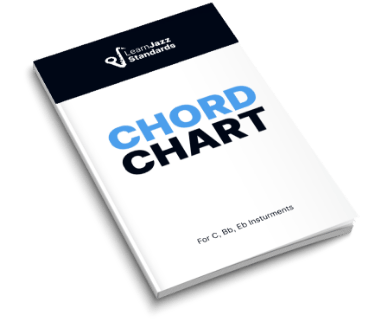Nothing says jazz guitar quite like the chord melody.
Mastering chord melody arrangements of jazz standards vastly improves your musicianship and teaches you to compose, arrange, and improvise at a higher level than with single-note solos or chords alone. Chord melodies take chordal and melodic improvisation and fuse them into an all-in-one performance.
This post will break down some strategies you can use to start arranging your own chord melody arrangements. As you’ll soon discover, there isn’t one set way to play a chord melody, and chord melodies have applications beyond solo guitar playing (hello, guitar trio!).
Want to learn how to play jazz guitar but don’t know how to get your guitar playing and jazz knowledge to the next level? You should check out the Learn Jazz Standards Inner Circle!
The Inner Circle has abundant jazz theory, improvisation, and instrument-specific (yes, guitar included!) courses designed to help you ignore distractions and focus on what matters when learning jazz. The Inner Circle helps you cut through all the noise and become a better jazz player.
Check out what the Inner Circle has to offer!
Table of Contents
What You Should Know Before Starting Chord Melodies
You’ll need to have a basic understanding of some music theory before starting.
Yes, you could learn the physical shapes and memorize the sequences of frets, but that leaves little room for internalizing, understanding, and developing what you are playing into different chord melody ideas.
It will be a much easier and more fruitful process if you understand what you are playing and why it works.
That’s why you’ll want to know:
- The major scale and minor scales (natural minor and melodic minor are fine to start)
- Major Triads in all inversions.
- Minor Triads in all inversions [link]
- Diminished and Augmented Triads in all inversions [links]
- Seventh Chord Voicings in all inversions [links]
- Diatonic Chord Scales in Triads and Seventh Chords in all inversions
This might seem like a tall order, but you don’t need to do it all simultaneously. You can pick one jazz standard and use that as the vehicle to learn these scales, shapes, voicings, and inversions.
The following section reviews the major scale, its modes, and how to play chord scales on different string groups.
If what we’re about to discuss is already familiar to you, feel free to skip ahead!
Major Scale, Modes, and Triad Basics
Let’s review the basics. You most likely know the major scale and are familiar with its modes.

To refresh, each scale degree in the major scale can act as its own root note. The major scale sequence remains the same, but the starting point (or what we feel as “home base”) is another note in the scale. There are seven notes and, therefore, seven modes.
- C Ionian: C-D-E-F-G-A-B-C
- D Dorian: D-E-F-G-A-B-G-D
- E Phrygian: E-F-G-A-B-C-D-E
- F Lydian: F-G-A-B-C-D-E-F
- G Mixolydian: G-A-B-C-D-E-F-G
- A Aeolian: A-B-C-D-E-F-G-A
- B Locrian: B-C-D-E-F-G-A-B
Triad Basics
Taking this one step further, we can harmonize each note in the major scale by thirds to find the diatonic chords in the key of C major:
C Ionian: C-D-E-F-G-A-B-C

D Dorian: D-E-F-G-A-B-G-D

E Phrygian: E-F-G-A-B-C-D-E

You probably get the idea by now!
Chord Scales
Here are all the diatonic triads in the key of C major. The original major scale is shown in color:

Let’s apply this chord scale to the fretboard! Notice how there are only three chord shapes in the following exercise—a major chord triad shape, a minor chord triad shape, and a diminished chord triad shape.

Here, we have a root position C major chord scale on the A-D-G string group. Ideally, you’d be able to play this chord scale on any string group and across strings.
Try this on these string groups, too:
- E-A-D
- D-G-B
- G-B-E
Here is the same chord scale, except we’ll move across the strings instead of staying on one string group.

The chord shapes above represent one way of playing this chord scale across the strings. Because of the unique nature of the guitar, there are many ways to play the same thing. It’s important to familiarize yourself with multiple ways of doing things!
We are being so thorough because we want to practice as many ways as possible when playing these chord scales. The more variations you’ve practiced, the more choices you have when performing or improvising in the chord-melody style.
Triad Inversions
So far, we’ve kept our chord scales in root position, but this isn’t always practical or necessary when playing chord melodies.
Usually, a guitarist will position melody notes at the top of chord voicings so the melody is clear and distinct. You’ll need to know triad inversions to place the root notes, thirds, and sevenths at the top of your chord voicings.
Here are first inversion and second inversion C major chord scales:
First Inversion Chord Scale

Notice that we are sticking to one string group for this exercise. In line with the previous examples, be sure to transfer this first inversion chord scale onto other string groups and play it across string groups.
Second Inversion Chord Scale

Eventually, you should be able to play these chord scales in all twelve keys and on any string group or combination of string groups. This will take time, so don’t rush, and trust the process! You don’t need to master this concept before you learn a chord melody.
Seventh Chords and Beyond
After getting comfortable with triads, you’ll want to apply the same practice to seventh chords, which are triads plus the root note’s seventh scale degree.
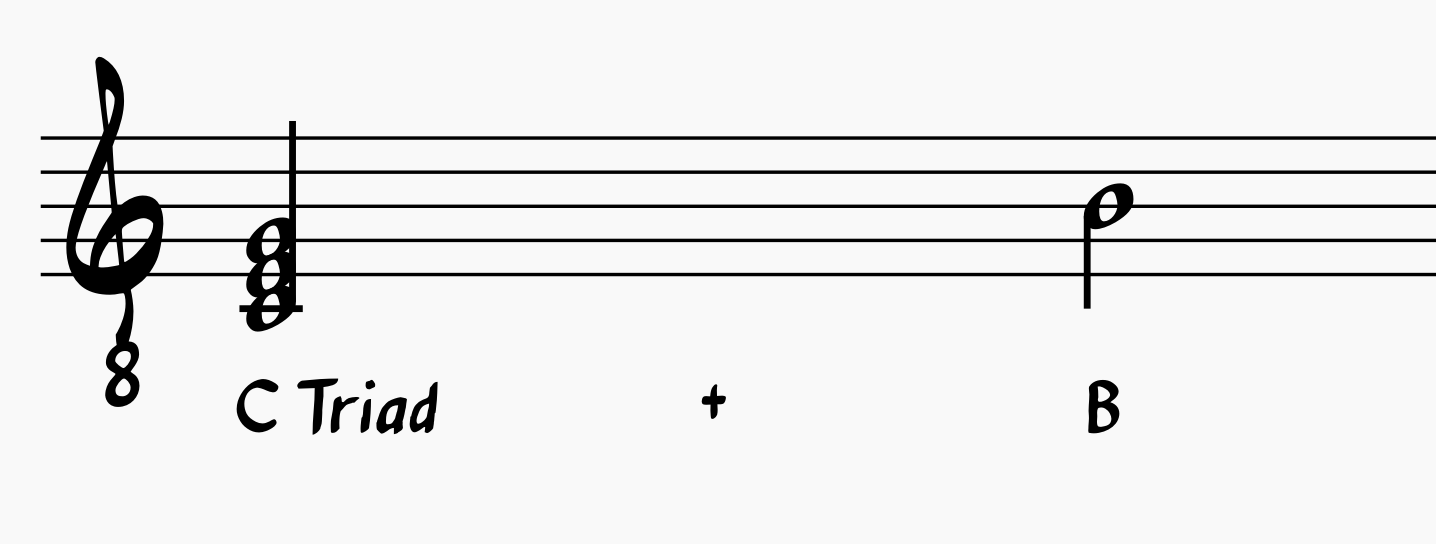
When we take a C triad and add the seventh scale degree (B), we get a Cmaj7 chord:
- C triad + B = Cmaj7

Much in the way we practiced triad chord scales, you’ll want to practice 7th chords the same way:
- Up and down different string groups
- Across multiple string groups
- all inversions—1st inversion, 2nd inversion, 3rd inversion
By doing this, you are building a solid foundation for developing chord melody skills.
But there is one more thing you should be doing…
The Importance of Listening and Transcribing
We’ve talked a lot of theory so far.
However, you’ll need to listen to actual chord melodies to hear the real-world applications of what we’ve discussed.
Your output is only as good as your input.
You need to feed your ears music in order to grow! Luckily, there are many great examples of chord melody arrangments from the jazz guitar greats. This musical broccoli will help inspire and expand your chord melody playing as you develop your own jazz guitar voice.
Chord Melody Arrangements
Finally! Let’s start thinking about different ways we can play a chord melody. First, our approach depends on the jazz tune we are playing.
Is it a ballad? A bebop head? A bossa? A blues or medium swing?
Ballads, medium swing tunes, and bossa nova tunes are probably the way to go for beginners. It’s really hard to play melodies and chords simultaneously over an up-tempo bebop tune (though it’s been done!).
Pick a harmonically simple tune with an easy melody line when deciding on your own arrangement.
Here are some examples:
- Autumn Leaves
- Days of Wine and Roses
- There is No Greater Love
- How Insensitive
- Beautiful Love
The ideal jazz tunes will have simple melodies that stick primarily to chord tones.
Things To Keep In Mind When Starting Your Chord Melody Arrangement
- Prioritize the melody notes by keeping them at the top of chord voicings—remember your chord inversions!
- You don’t need a chord under every melody note—you can often state the harmony by playing chords at the beginning of harmonic changes (usually beat 1 of a measure).
- Try to find different ways of playing the same thing—move your chord melody to a different string group and figure out how it lays on the fretboard
- Practice slowly! There’s no rush.
Different Approaches to Chord Melody Playing
As you listen to different guitar players, you’ll realize there are many ways to outline the harmony and melody at any given moment. Some players will stick to one approach, while others will blend various approaches.
There are the bold and infectious block chords and chord soloing of Wes Montgomery or the intricate classical guitar-sounding arrangements of Joe Pass, which weave in and out of harmonized melodies and single-note runs.
Then there are the modern players who imply the chord changes by pairing the melody note with one or two other notes in a minimalistic fashion in a guitar trio setting. It’s probably a good idea to try your hand(s) at many different styles to see which ones resonate the most with you.
Next, you’ll want to consider how you’ll play it. Will you play it in time or rubato? Will you use a pick or your fingers, or will you take a hybrid picking approach?
With all these considerations in mind, let’s break down some great places to start when devising your own chord melody arrangement.
Step 1: Bass Notes With Melody on There Will Never Be Another You
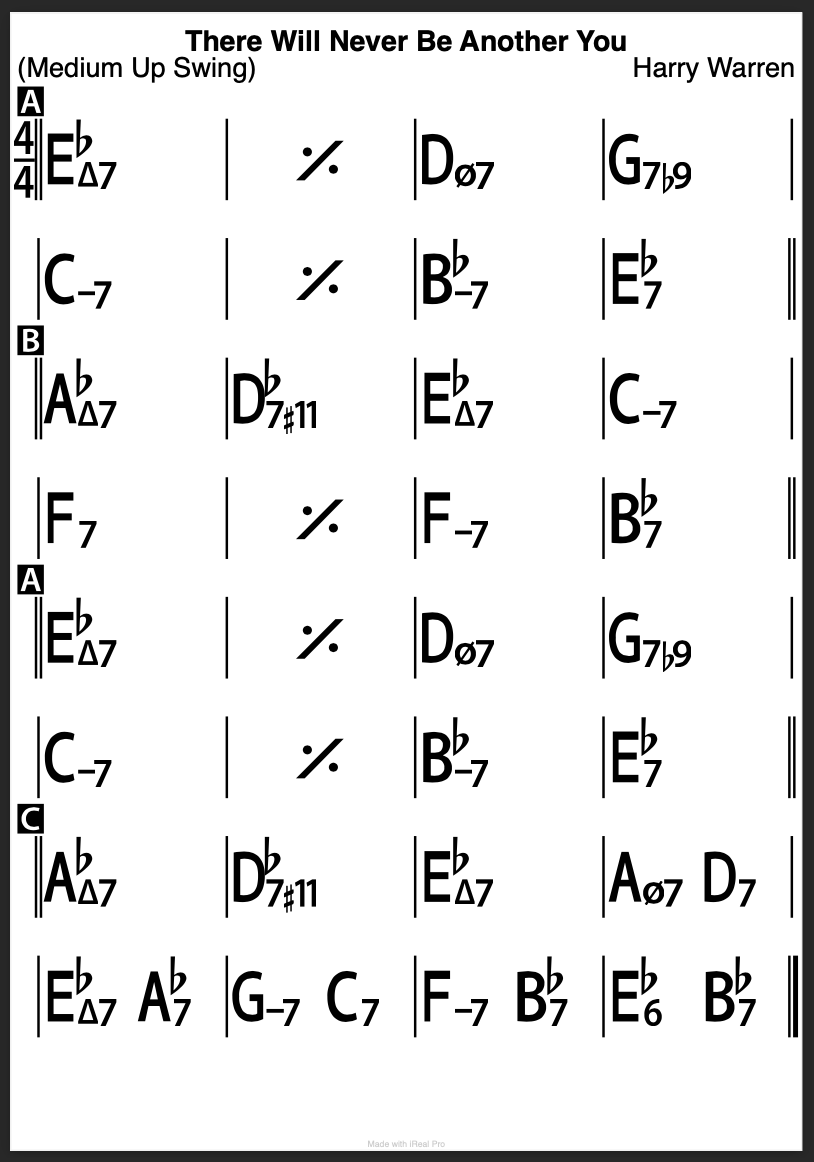
A great place to start is combining the melody with the bass line and filling in the harmony afterward.
Let’s try playing a melody while simultaneously playing bass notes. There are multiple ways to approach this with your picking hand—you can use finger picking, hybrid picking, or strum through multiple strings while muting unwanted strings with your fretboard hand.
There Will Never Be Another You Basic Root Notes and Melody
We’ll use the tune There Will Never Be Another You for this particular example. Here are the first 8 bars showing the melody and root notes of the harmony:
Bars 1-4

Bars 5-8

The idea here is to get comfortable spitting up your picking hand into two voices—the bass and melody notes.
We are only hitting the root notes of the chords underneath the melody so that it may sound harmonically ambiguous. But there is enough information in the melody line that your brain will fill in any gaps, especially if you are familiar with the tune.
Bars 9-12

Bars 13-16

For context, here are all 16 bars together:
This bass note/melody line approach seems straightforward enough, especially on chords that last two whole measures, like the Ebmaj7 at the beginning of the tune, the C-7 in bars 5 and 6, or the F7#11 in bars 13 and 14.
These longer stretches of static harmony in the chord progression allow us to add more chord tones to the bass line.
BEFORE YOU CONTINUE...
If you struggle to play amazing jazz solos and want to learn the secret strategies the pros are using to improvise, our free guide will get you on the right track.

There Will Never Be Another You Basic Root Notes and Fifths With Melody
Here are sections of the tune where one chord lasts two measures. Instead of staying on the root as we did in the previous examples, now we’ll move from the root to the fifth on the second measure of each two-measure chord.
Bars 1-4

Bars 5-8

Bars 13-16

There Will Never Be Another You Basic Root Notes, 3rds, 5ths, and 7ths With Melody
We can further progress this bass note/melody line concept by changing the root note every two beats. This will allow us to hit even more of the harmony in our chord melody.
Bars 1-4

Bars 5-8
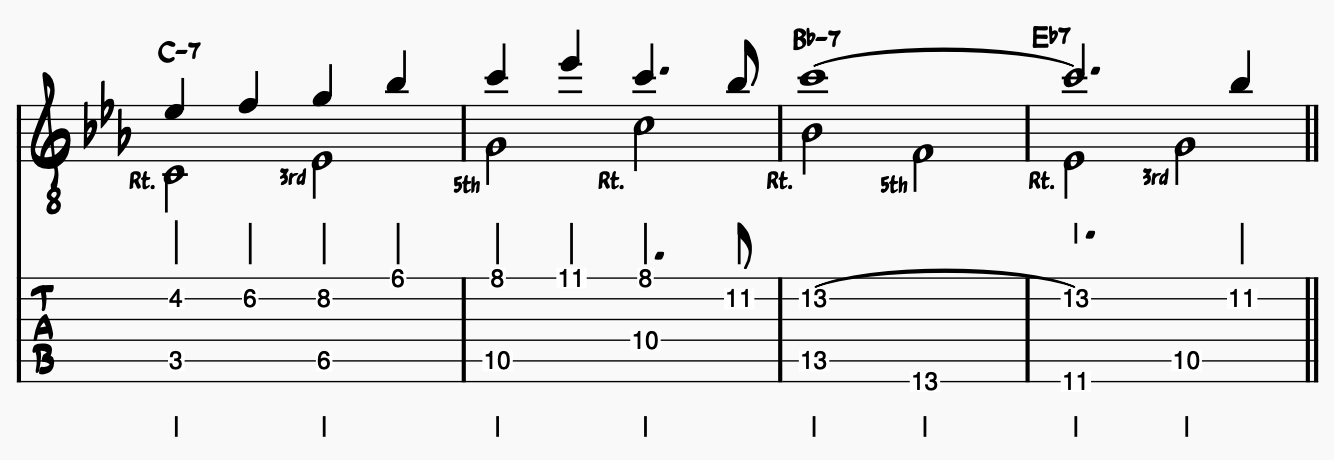
Bars 9-12
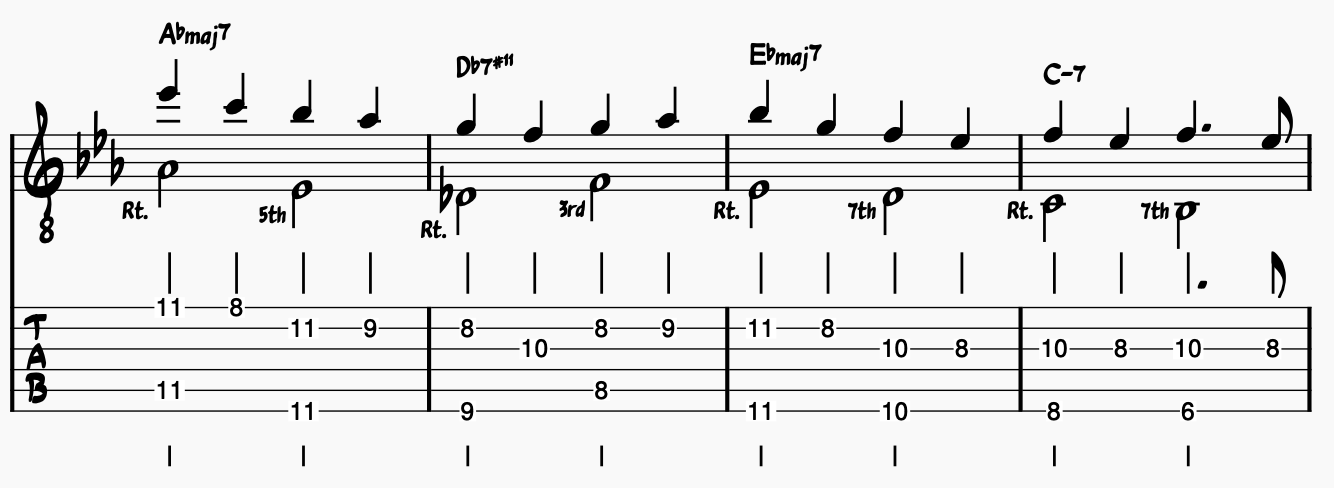
Bars 13-16

For context, here are all 16 bars together:
You likely wouldn’t want to play an entire chord melody arrangement in this fashion during a performance. However, as an exercise, doing this will help bolster your chord melody skills and help you think in multiple voices, leading to immense creative possibilities on your guitar.
So far, we’ve worked on playing with two voices, which is a crucial part of playing in the chord melody style, but we haven’t yet played traditional chords.
Let’s add chords into the mix!
Step 2: Using Triads And Keeping the Melody Note the Top Voice
In this next section, we will mix triad shapes with a melody to practice combining each in a way that flows naturally. Let’s switch standards since we have a new concept to work on.
Fly Me To The Moon is a popular and simple standard through which we can practice this concept, as it is (mostly) diatonic, and the melody is fairly straightforward.
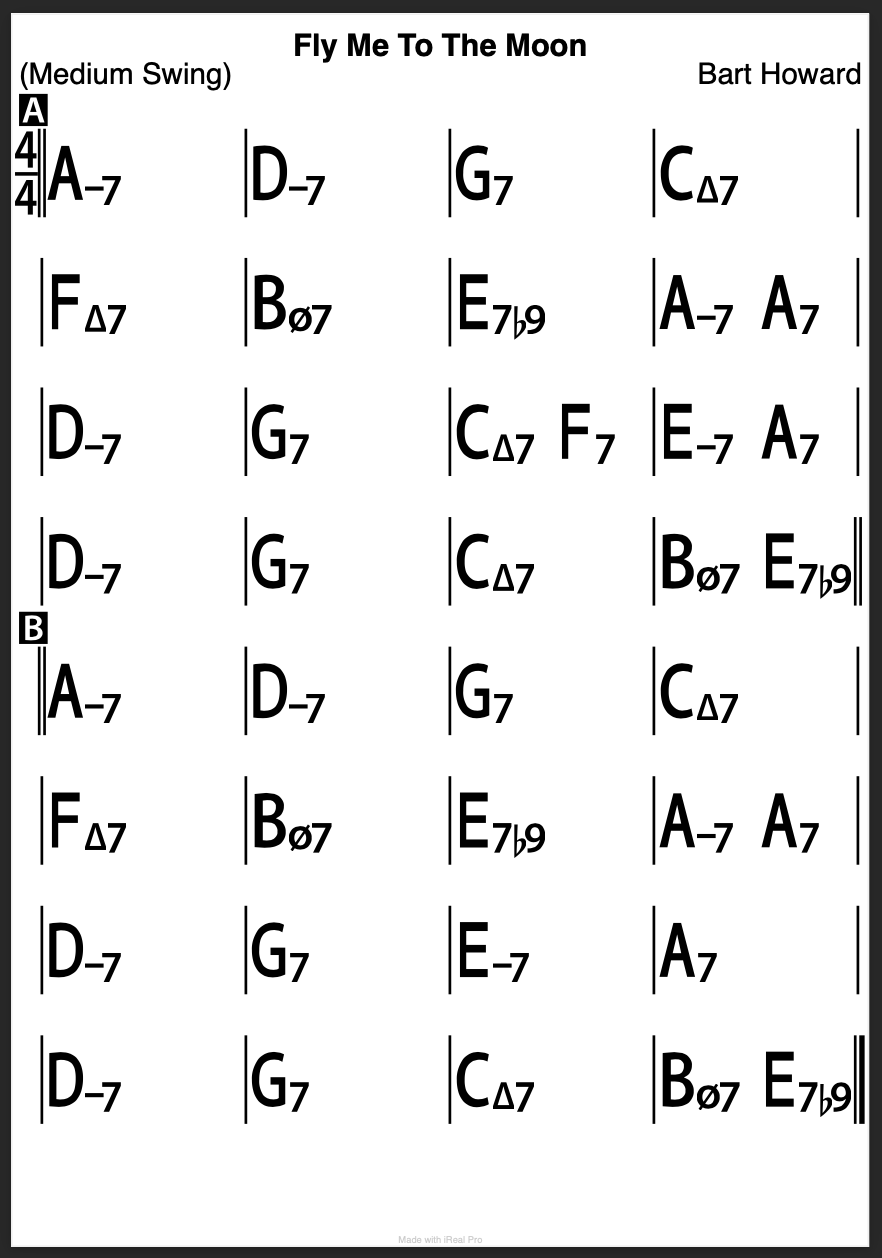
Punctuating The Melody With Triads On Chord Changes
Bars 1-4

You’ll notice that the melody note on beat one of each measure falls on the 3rd of each chord.
- C in the first measure (A-7)
- F in the second measure (D-7)
- B in the third measure (G7)
- E in the fourth measure (Cmaj7)
This means we can use second inversion triads (over the 5th) to punctuate the harmony on the downbeats of each measure.
The same goes for the next four bars:
Bars 5-8
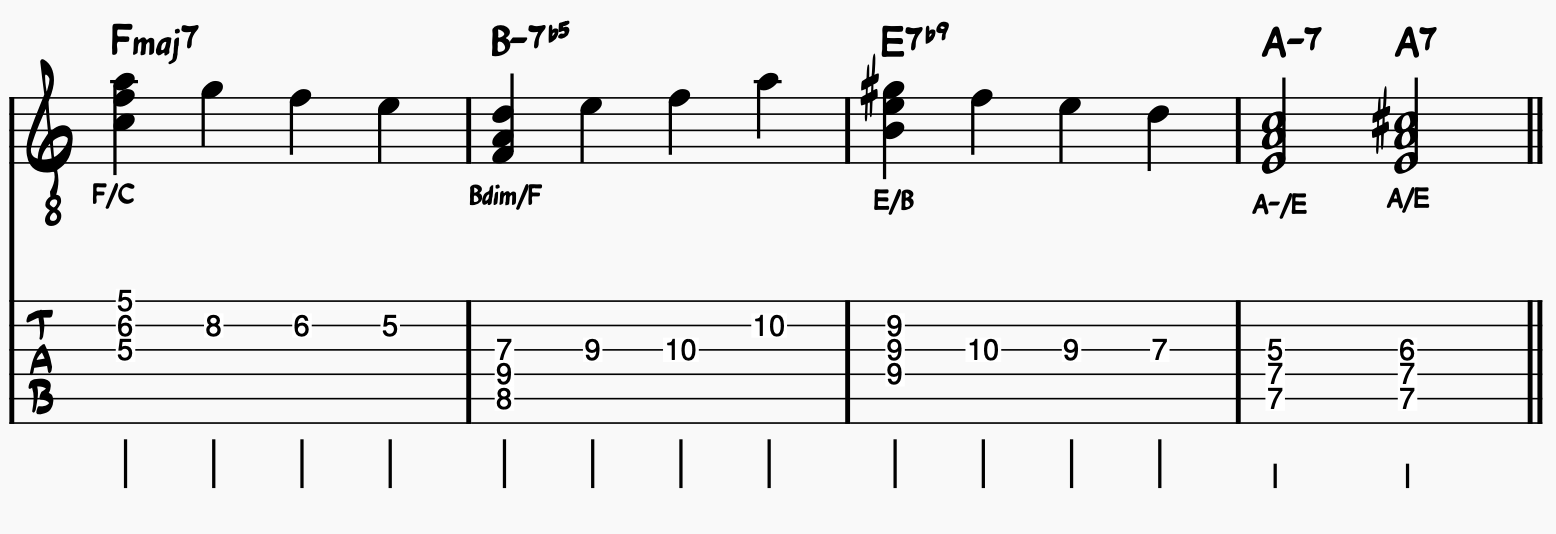
- A in the fifth measure (Fmaj7)
- D in the sixth measure (B-7b5)
- G# in the seventh measure (E7)
- C and C# in the eighth measure (A-7 and A7)
Here are all 8 bars together:
This great exercise will help exponentially improve your chord melody playing. However, we aren’t limited to basic triads—this concept also works for seventh chords.
Punctuating The Harmony With Seventh Chords On Chord Changes
For the following section, we are using root position seventh chords to punctuate the harmony on downbeats.
You’ll notice first inversion triads in parenthesis written in between the tablature and the staff. These show the same 7th chord voicings with the root removed. When playing a chord melody in a setting like a guitar trio, you can usually omit the root as the bass player will grab it.
Bars 1-4
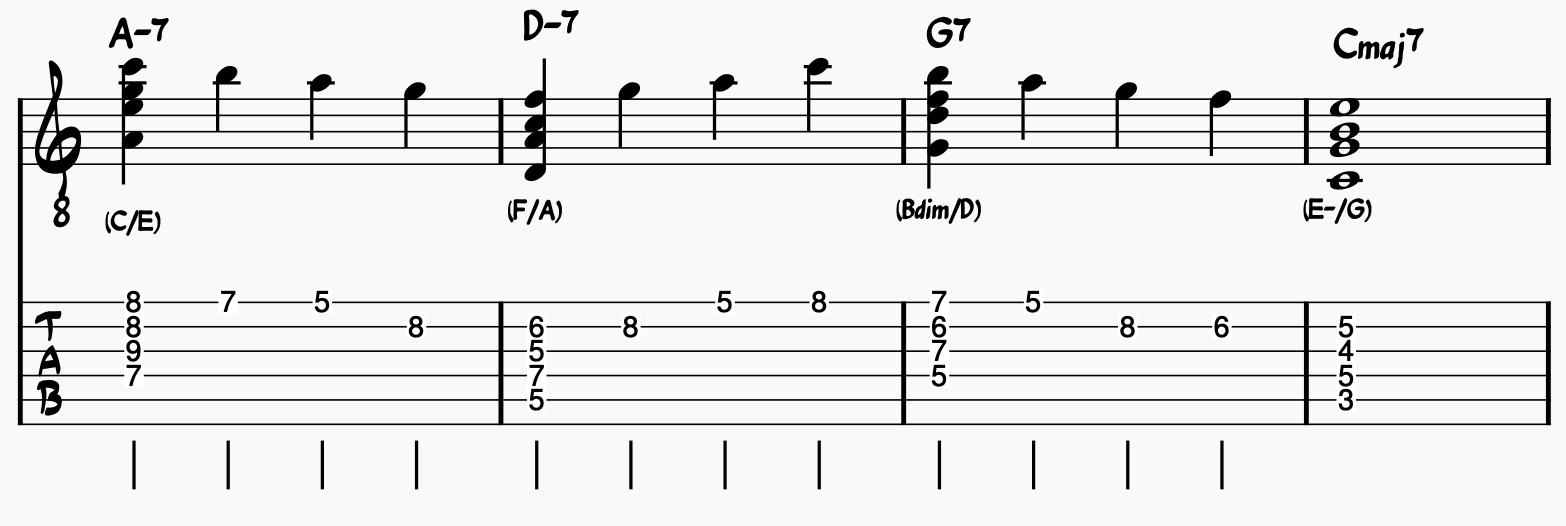
With these particular root position seventh chord voicings, the third is always the top voice, which helps with this particular standard.
- C in the first measure (A-7)
- F in the second measure (D-7)
- B in the third measure (G7)
- E in the fourth measure (Cmaj7)
Bars 5-8
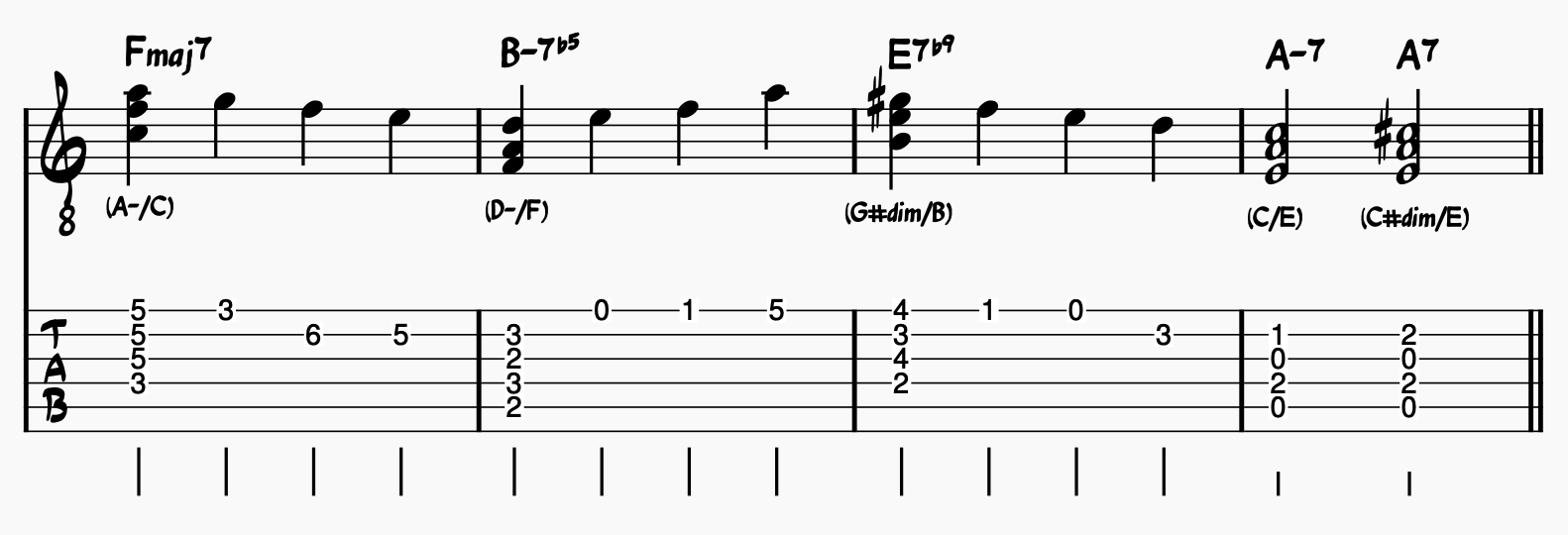
- A in the fifth measure (Fmaj7)
- D in the sixth measure (B-7b5)
- G# in the seventh measure (E7)
- C and C# in the eighth measure (A-7 and A7)
Here are all 8 bars together:
In the previous examples, we’ve placed chords on the downbeats of harmonic changes, but you aren’t limited to this when devising your own chord melody arrangements.
Step 3: Putting It All Together
There is a big difference between practicing a concept and performing a tune. The exercises we’ve discussed above are meant to help you understand concepts you can employ when performing a jazz standard as a solo guitarist.
You wouldn’t want to play an entire song with block chords on downbeats or with a strong bass line. However, you need to practice this way to master these concepts. Then, when you feel confident, you need to forget all that and play.
After practicing concepts like bass lines or block chords rigidly, you should practice playing as if you were performing.
In the following example, I’ll blend these concepts and employ them in a one chorus chord melody on Fly Me To The Moon. However, the chord melody won’t be comprised entirely of block chords or strict bass lines.
Some things to listen for:
- I’ll take some liberties with the melody and avoid the rigid quarter-note feel found in the Real Book.
- Sometimes, I play the melody all by itself and only hit important chords to push the harmony forward. However, these chords are rarely larger than three notes. Sometimes, I play rootless shell voicings (3rds and 7ths) to keep the harmony moving without overloading the tune.
- Sometimes, I throw a bass line in to have a dialogue with the melody, but the bass line is never constant. I use it to accentuate the melody and add a larger range to my chord melody.
- I’m never doing one thing for long! I’m always trying to change things up and keep it fresh.
- In this particular recording, I’m keeping time (until the very end) and swinging (unlike earlier exercise examples where I played it straight).
Check it out:
More Chord Melody Resources
Also, check out these LJS resources on chord melody arrangements:
- Polkadots and Moonbeams podcast episode
Also, check out this supplementary video that discusses chord melody basics. This video will go over some other things you should think about when crafting your own chord melodies:
Ready to Take Your Chord Melody Skills To The Next Level? Join the Inner Circle!
If you want to improve your jazz guitar chops, master the fretboard, and learn jazz theory, then you should join the Learn Jazz Standards Inner Circle.
The Inner Circle has everything you need to master jazz guitar and become the best jazz musician you can be—including guitar-specific courses designed to help take your jazz guitar skills to the next level.
Ready to master the art of the chord melody? Check out what the Inner Circle has to offer!









